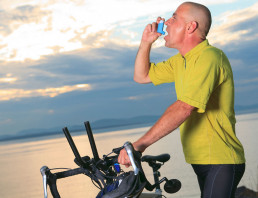Is it COVID or Is it My Allergies?
Is it COVID or is it my allergies?
Spring is the season of pollen and that means allergies. But what if you are experiencing symptoms how do you know it is not COVID and it's just your alleriges?
Symptoms of COVID vs Allergies
Well per the CDC symptoms of COVID include a cough, fever, and sore throat. With allergies you will not experience a fever. This is a big clue that if you have a fever, it's probably something other than your allergies.
WIth allergies you may experience itchiness in your throat, but it should not feel sore. Also, with allergies you may experience itchy eyes, nose and ears.
With COVID you might feel extreme exhaustion, this not common with allergies. In addition, if it is your allergies you might have a runny nose and congestion and possibly a cough. However if you are feeling short of breath, where you are having trouble breathing this is probably not due to your allergies and is something else that needs medical attention.
If you are having trouble breathing or experiencing bluish lips or face, confusion or persistent pain or pressure in the chest you should seek medical attention immediately.
This post is not designed to substitute medical advice from your provider. If you have concerns, please always contact your healthcare provider.
References
- https://www.cdc.gov/coronavirus/2019-ncov/symptoms-testing/symptoms.html accessed on 11/27/2020
Exercise Induced Bronchospasm (EIB)
Exercise Induced bronchospasm (EIB) was previously known as exercise induced asthma. This term is no longer used as it incorrectly implies that exercise causes asthma. Around 90% of people with asthma also have EIB. However not everyone that has EIB has asthma.
Symptoms may include cough, wheezing, shortness of breath, upset stomach, chest tightness and sore throat. Coughing is the most common symptom and may also be the only symptom. Symptoms may not appear until a few minutes into your work out and may then continue for additional 5 to 10 minutes after stopping exercise.
A common belief is that cold temperatures may cause asthma, but research has shown that it may be more due to dry air than temperature. Cold air tends to have less moisture than warm air, making it drier. When dry air is breathed in quickly this leads to dehydration of the bronchial tubes resulting in airway narrowing (bronchoconstriction).
EIB may also be trigged by pollution, high pollen, and exposure to irritants, such as smoke or strong fumes. Chlorine from swimming, as well as air temperature during hot yoga may also be triggers.
Some tips include….
- Covering your mouth with a scarf if exercising in cold, dry weather.
- Ensuring to take your medication prior to exercising.
- Performing a warm up prior to exercise or vigorous activity.
- If you have a child with EIB, ensure that all teachers and coaches are aware.
Medication options include the follwoing:
- Short-acting beta agonist include rescue inhalers such as albuterol, also known as ProAir or Ventolin. These medications should be administered 15 minutes before exercise. This class of medication is considered the treatment of choice for EIB. They should always be on hand to help with breakthrough symptoms.
- Long-acting beta agonistinclude salmeterol (Serevent) and formoterol (Foradil). These medications should be administered at least 30 to 60 min before exercise. When these medications are used for a long period of time protection may be lost after the 12 hour dosing interval. This class of medication is only used for prevention and not treatment and used only once within a 12 hour period.
- Mast cell stabilizersinclude Cromoyln sodium and nedocromil. This class of medication may be used for prevention and exacerbation related to exposure to other asthma triggers. These medications should be administered no greater than 1 hour prior to exercise.
- Leukotriene modifiersinclude montelukast (Singulair). This mediation is taken once daily to help prevent symptoms related to EIB.
All these medications are prescription only and should be discussed with your primary provider and pharmacist.
The role of Leukotrienes
Leukotrienes are fatty acids derived from arachidonic acid (AA). These fats cause inflammation binding to receptors in the bronchial and airway tissue during an asthma attack. This causes bronchoconstriction.
Leukotriene modifiers include pharmaceuticals: montelukast, zafirlukast, and zileuton. These medications block leukotrienes by one of two ways:
- Working on mast cells and eosinophils to prevent leukotriene release
- Preventing leukotrienes from binding to receptors on bronchial tissues
Fish oil contains omega-3 fatty acids specifically, EPA and DHA. These fats have anti-inflammatory properties that decrease inflammation and improve lung function. They work by competing with AA, reducing the synthesis of leukotrienes and also inhibiting the production of AA leading to less inflammation.
Good sources of omega-3 are the following: salmon, cod liver oil, mackerel and tuna. Just remember that consuming a high diet in fish may increase your risk for mercury toxicity, and therefore moderation is key.
If you have asthma or symptoms stop by our pharmacy and we can work with your provider to find a treatment plan that is best for you.
References
- https://pubmed.ncbi.nlm.nih.gov/2844278/Accessed on May 19, 2020
- https://pubmed.ncbi.nlm.nih.gov/7926711/Access on May 19, 2020

